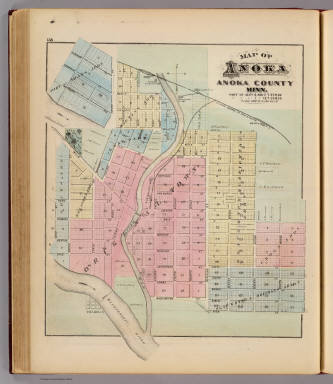SEPTEMBER 2, 2019 – Friday, while at historic Fort Snelling just outside Minneapolis, I was struck by a map of Minnesota on which just a handful of names appeared—neither of the Twin Cities (Minneapolis and Saint Paul) being among them. The map depicted important sites in the lore and history of the Dakotah Indians who occupied this territory before more powerful forces invaded. Among those sites was my home town of Anoka.
As the reader of this blog site might remember (see July 31), my father was a serious student of history, particularly of the American persuasion. He had special admiration for Indians and read extensively about them. His two all-time heroes were the great strategists Tecumseh of the Iroquois Nation and Chief Joseph of the Nez Perce. (Sadly, after his defeat, Chief Joseph was exiled to a barren reservation in Oklahoma. The train that bore him as prisoner made a stop at Union Depot in downtown Saint Paul, just six miles from where I write this.)
When I was old enough for Dad to consider me his “history buddy”—about the time I entered kindergarten—he informed me that “Anoka” was an Indian term meaning “on both sides of the river.” This made sense to me, since our town did, in fact, occupy both sides of the Rum River around its mouth at the Mississippi.
Until last Friday, my wife, who for good reason doubts many of my declarations, was skeptical of my translation of “Anoka.” She had always known it simply as “The Halloween Capital of the World,” which it most certainly is . . . at least by self-proclamation and big-deal Halloween parade every year down Main Street.
Years ago on a visit just as we crossed the Rum River and took the exit marked “ANOKA / FERRY STREET,” my good wife casually asked me about the origins of “Anoka” (as opposed to the town’s Halloween history—the stuff of a single blog post. Stay tuned.). When I told her, she said, “Oh, I don’t think so; a better chance it means, ‘bullshit.’” My insistence fueled greater skepticism.
But there at Fort Snelling last Friday arose a surprise chance for vindication. As my wife listened intently, the Minnesota Historical Society staffer presented the aforementioned map and launched into a short discourse on Dakotah geography. I immediately formed a strategic question: “What does ‘Anoka’ mean?” I asked, placing my right index finger directly below the sacred name on the map. Before the staff person could respond, I added the prompt, “On both sides of the river?”
With autumn in the air, I felt as though a touchdown pass was in my hands. The only question was whether I could hang onto the ball as my feet descended into the end zone. I imagined the scene in slow motion . . .
“Yes, I think that’s right,” the knowledgeable staff person replied.
“Hmmm,” my wife acknowledged with affirming inflection.
Touchdown!
© 2019 Eric Nilsson

1 Comment
Dear Eric, My property law prof in “One L” was a terror. He ran his (large) class like a base training camp; he seemed to fancy himself a latter-day Gen. Patton (the George C. Scott variety). When called upon in class, each of us was expected to stand up erectly and respectfully and respond in a strong loud voice to whatever impertinent question he might care to pose. We were to state our full name and the place whence we hailed. The class woke up when I, so intrepid a student, was finally called upon one fine morning. Upon being pointed at with his imperious finger, I responded, “Kristina Nilsson, SIR. From Anoka, Minnesota. Anoka, meaning “on two sides of the river. SIR.” I swear he cracked a smile — the only one of the school year that I recall. Love, Nina
Comments are closed.